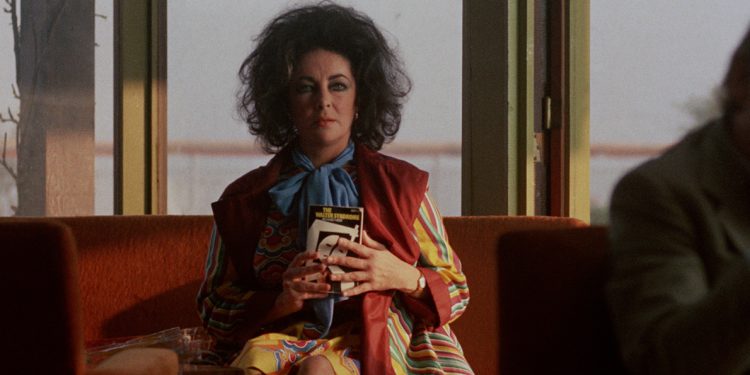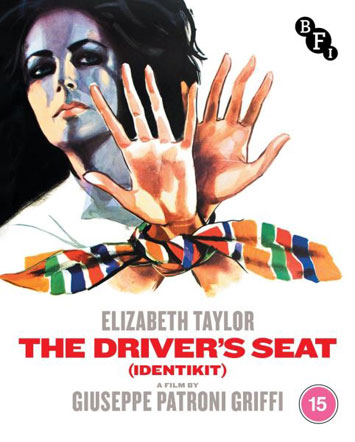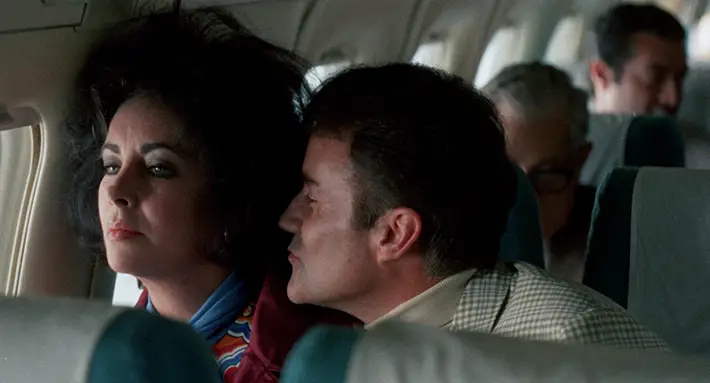The Driver’s Seat (1974) – Film Review

Director: Giuseppe Patroni Griffi
Cast: Elizabeth Taylor, Ian Bannen, Guido Mannari
Certificate: 15
By Sarah Morgan
Elizabeth Taylor – the epitome of Hollywood glamour and one of the greatest stars who ever lived.
Few would disagree with those points, but it’s perhaps because she was so beautiful that seeing her slumming it a little becomes so intriguing and enticing.
Taylor famously put on weight and tried to make herself look older for her Oscar-winning performance in Who’s Afraid of Virginia Woolf? in 1966. Eight years later, she proved again that she wasn’t ruled by vanity when she took on one of her most fascinating roles in The Driver’s Seat, an adaptation of Muriel Spark’s 1970 novella of the same name.
 Her hair is backcombed to oblivion with a silver streak or two, she’s carrying a little extra timber (but still has an enviable figure), her make-up is far from perfect and her clothing is garish, to say the least. All these are indicators of her character’s state of mind and the image she wants to present to the world.
Her hair is backcombed to oblivion with a silver streak or two, she’s carrying a little extra timber (but still has an enviable figure), her make-up is far from perfect and her clothing is garish, to say the least. All these are indicators of her character’s state of mind and the image she wants to present to the world.
“Particularly creepy”
Taylor plays Lise, a clearly unbalanced middle-aged woman who suddenly decides to travel from her home in Germany to Rome, a city in a state of flux – not unlike Lise herself. The story is told in a non-linear fashion, so we get glimpses and hints at her fate via police interviews with the people she met and interacted with on the way to her death, which she seems to have organised herself.
Throughout her journey, Lise appears to be in a heightened state, attracting and repulsing strangers along the way. Ian Bannen is particularly creepy as a lecherous businessman who, bizarrely, claims he must sleep with her as part of his macrobiotic diet, while Mona Washbourne also pops up as a pensioner with whom Lise goes on a revealing is disastrous shopping trip.
Watch out too for Andy Warhol in a cameo as an aristocrat. I suspect his voice was dubbed; either that or the artist could carry off a more than respectable English accent.
Directed by Guiseppi Patroni Griffi, this Italian psychological drama is largely forgotten, but it’s an extraordinary piece of work. Griffi creates a foreboding atmosphere via some stunning images and by eking out the very best from his cast.

“Enthralling”
Taylor had, apparently, started work on the film a day after securing her first divorce from Richard Burton (they would remarry a year later), and so was feeling unshackled, free to throw herself into the production.
That perhaps contributes to her overblown performance in The Driver’s Seat. Which sounds like a derogatory comment, but isn’t; Lise simply wouldn’t work if she was meek and mild – she needs to be larger than life. The character is desperate to make some kind of impression on the world (hence her penchant for outlandish outfits), so consciously ensures she’s seen and remembered. Whether you like and understand her or not isn’t particularly important, but compassion towards her does develop as she edges ever closer to her self-designed fate.
The Driver’s Seat is one of the most enthralling films I’ve seen for a while, and I’m sure that the more I watch it, the more I’ll glean from its depiction of a woman who needs to take control of her destiny, but struggles to do so due to the behaviour of others.
Don’t skip over the special features either. There’s some fascinating stuff on offer here, including an insightful talk about the film and author Spark by literary historian Chandra Mayor.
⚫ Restored in 4K by Cineteca di Bologna and Severin Films, and presented in High Definition
⚫ Introduction by Kier-La Janisse, author of House of Psychotic Women (2022, 6 mins)
⚫ Audio commentary with curator and programmer Millie De Chirico (2022)
⚫ A Lack of Absence (2022, 22 mins): writer and literary historian Chandra Mayor on Muriel Spark and The Driver’s Seat
⚫ The Driver’s Seat credit sequences (1974, 4 mins)
⚫ Darling, Do You Love Me? (1968, 4 mins): in a parody of her media persona, Germaine Greer stars as a terrifyingly amorous woman who pursues a man relentlessly
⚫ Waiting For... (1970, 11 mins): a woman embarks on a filmmaking project after being given a camera and told to capture her everyday reality
⚫ The Telephone (1981, 4 mins): a young woman enacts imaginative revenge on her boyfriend
⚫ National Theatre of Scotland trailer (2015, 2 mins): a promotional clip for the UK’s first stage production of The Driver’s Seat
The Driver's Seat is released on Blu-ray by the BFI, £19.99









